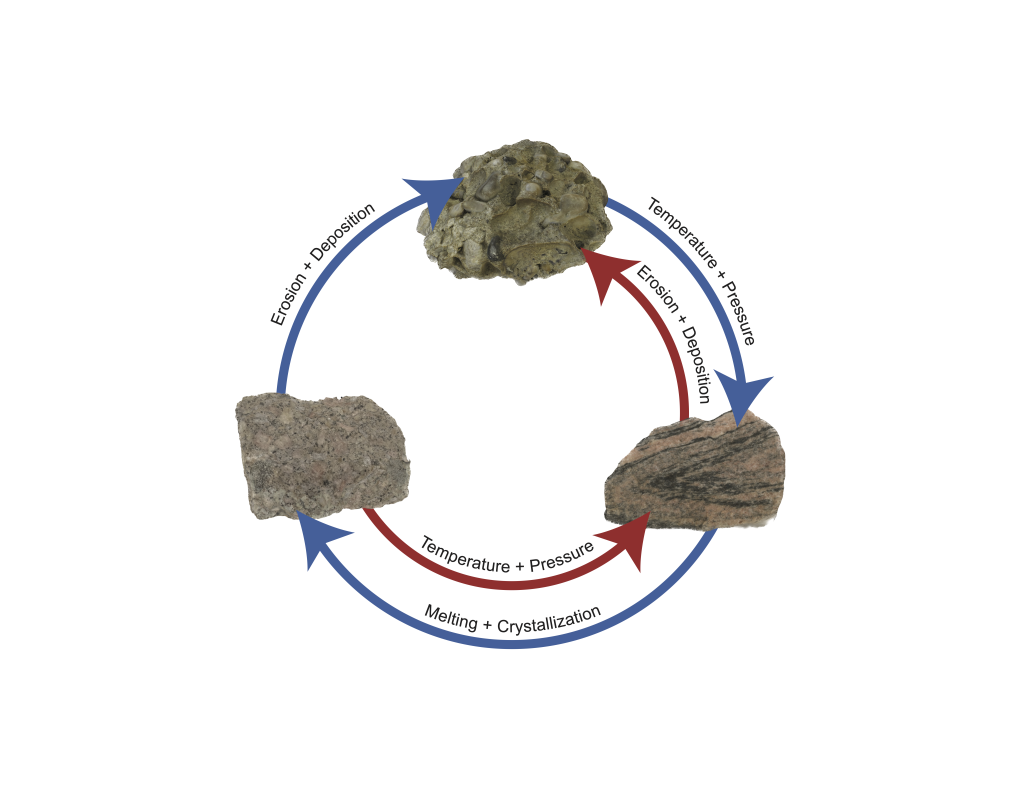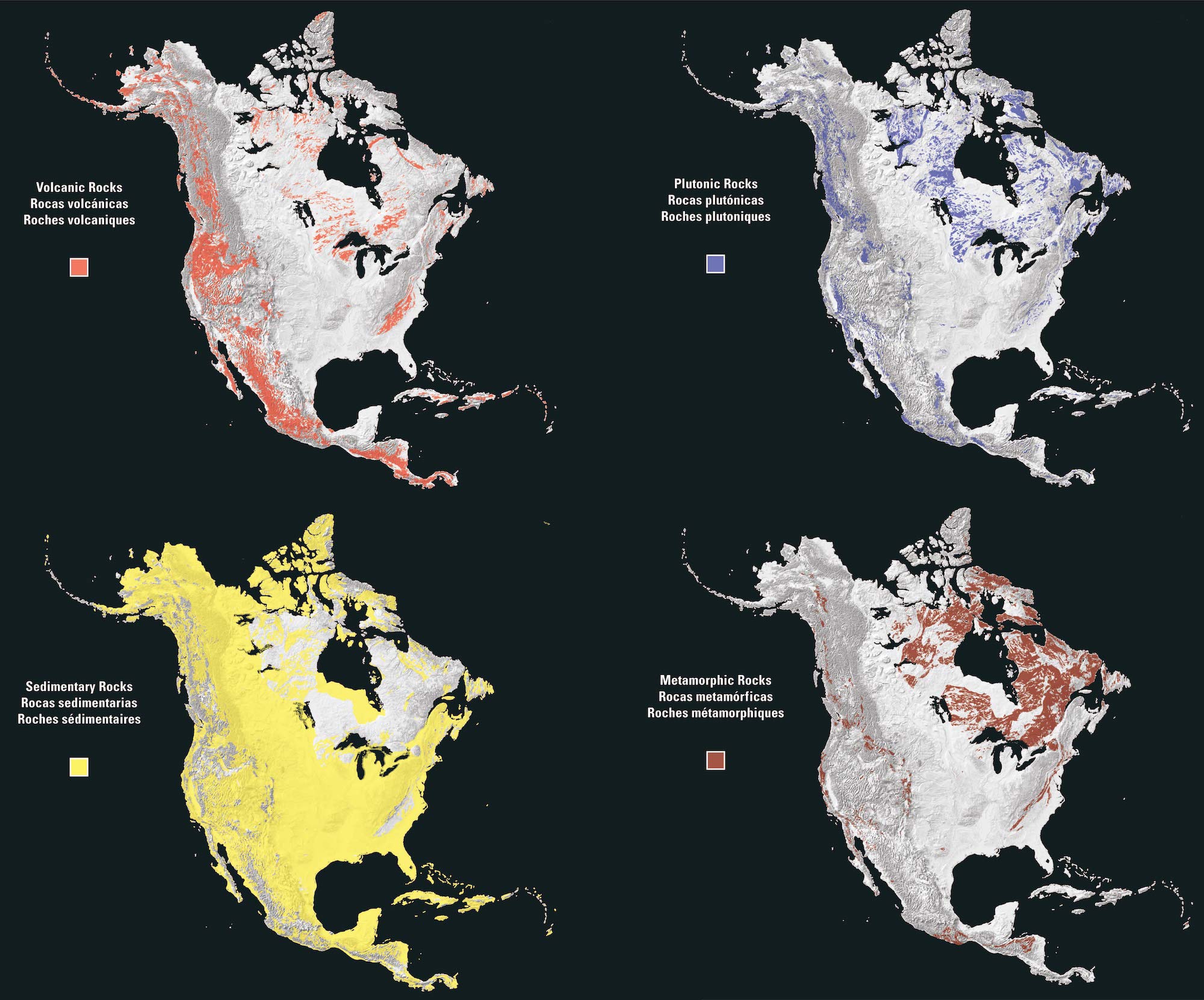This book contains exercises for a physical geology lab class. It is under development, with a full 1st edition release planned for Fall 2024.
Learning Objectives
The goals of this chapter are to:
- Recognize three rock types and how they form
- Compare and contrast rock types
- Evaluate the distribution of rock types in North America
4.1 The Rock Cycle
You probably have already learned about the rock cycle in an elementary science class; this is a series of processes that create and transform types of rocks on Earth and other planets (Figure 4.1). Yes, the rock cycle applies to other rocky planets such as Mercury, Mars, and some moons. Not only are there three types of rocks, but there are also processes that tie these together. So, the rock cycle is more complicated than just simple rock types. These different processes result in distinctive textures; you might think this means rocks are smooth, rough, bumpy, lumpy, gritty, or a combination of textures. Instead, for rocks, texture includes the size, shape, and arrangement (or fabric) of the mineral grains and crystals.

Exercise 4.1 – Recognizing Rock Textures
Your instructor has given you three different rocks.
- Create a sketch of each rock in Table 4.1. Sketches should take no more than 1 minute and capture the essential features.
Table 4.1 – Sketching textures Rock 1 Sketch: Rock 2 Sketch: Rock 3 Sketch: - Are there any similarities between these rocks? Describe them.
- Are there any differences between these rocks? Describe them.
4.2 Rock Formation
Igneous rocks form as magma or lava (molten rock) cools off and solidifies. As the magma cools, minerals crystallize, growing intertwined with each other and forming an interlocking texture. You might see this referred to as a crystalline texture. Sedimentary rocks form when pieces of existing rock become cemented together or when sediment particles precipitate and become cemented together. Metamorphic rocks form when pre-existing rocks are altered by heat and pressure.
Exercise 4.2 – Understanding How Rocks Form
In this exercise, you will learn how rocks form using analogues. Your instructor will provide demonstrations and ask you to make observations and/or sketches.
These experiments are based on those by Allan Ludman and Stephen Marshak in Laboratory Manual for Introductory Geology.
You can also do two open-access alternatives that use chocolate and crayons to demonstrate how rocks form.
The first step to identify a rock is to categorize the rock into one of the three main types or groups of rocks. The only rocks which do not fall into one of these categories are meteorites. Igneous, sedimentary and metamorphic rock types are distinguished by the processes which form them. Some of the observations you need to make are similar to minerals such as color. But others such as cleavage and hardness only apply to minerals within rocks. For many rocks, it is texture that distinguishes them from other types of rocks.
Exercise 4.3 – Determining Rock Types
Your instructor has given you a set of rocks. Using your knowledge of how rocks form and their textures, classify your rocks as igneous, sedimentary, or metamorphic. Fill in Table 4.2.
| Igneous Rock Samples | Sedimentary Rock Samples | Metamorphic Rock Samples |
|
|
4.3 Why Study Rocks?
Why should you study different types of rocks? Well, they all contain clues about what the Earth was like in the past. Perhaps one area may have sedimentary rocks which experienced changes as extreme as changing from a desert to a swamp to a coral reef under the sea. Different rocks form under only certain conditions and even the dullest gray rock can tell us something important about the past. Some types of things that rocks can tell us about our planet as well as other planets are:
- Was there a lake or a volcano present where the rock was found?
- Was there a mountain range or a sea?
- Was it hot or cold?
- Was the atmosphere thick or thin?
For example, by understanding where volcanos have occurred in the past, we have a much better idea of where they are likely to occur in the future and can be prepared for them. Second, by gaining an understanding of how planets work, we can better predict how the Earth will react to changes. If we understand how the Earth and its life responded to temperature changes in the past, we might better understand the effects of the global warming that is happening today.
So the basic point is to better understand our world. This helps us to better coexist with nature and reap the benefits that it has to offer.
Exercise 4.4 – Rock Types in North America
Look at the distribution of rock types at the surface in North America (Figure 4.1) and answer the following questions. Remember that these maps show you rocks at the surface of the Earth.

- What is the most abundant rock type in North America? ___________________
- Describe the distribution of each rock type. For example, do you see any patterns or are those rocks only located in certain areas?
- Critical Thinking: These maps only show what is exposed is at the surface. Why does one rock type cover most of North America?
- Critical Thinking: Cratons are the nuclei of continental plates composed of intrusive igneous and metamorphic rocks. Where do you think the craton of North America is located? What is your reasoning?
Additional Information
Exercise Contributions
Daniel Hauptvogel, Virginia Sisson
A series of processes which relate rocks in Earth, including igneous intrusion or extrusion, weathering, erosion, transport, deposition as sediment, which lithifies into sedimentary rock, metamorphism, remelting, and leading again to igneous activity

